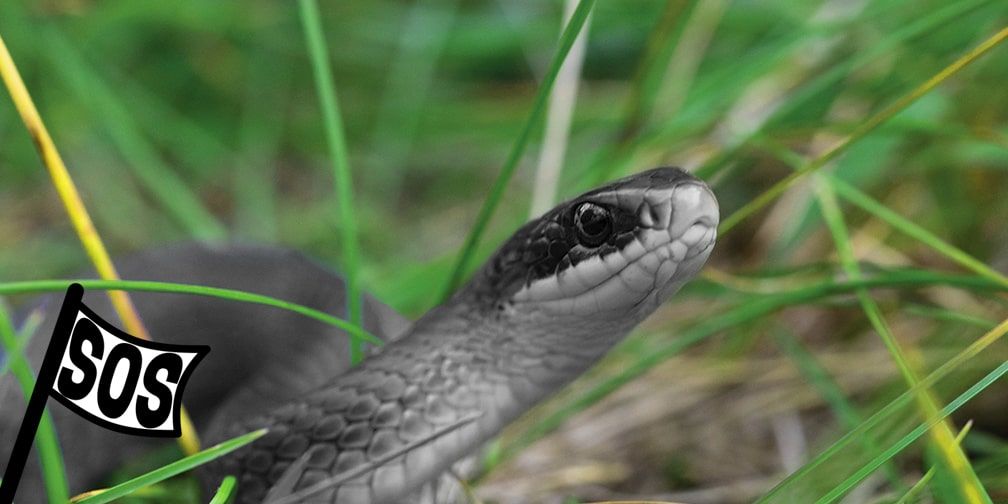

Have you seen the blue racer snake before? Let us know, we would love to see your pictures! Keep up with the rest of our Ohio Wildlife Series in future articles. OPLIN notes that blue racers will hibernate through the winter in large groups and with other species of snakes. The snake will then vibrate the tip of their tail, common of many other species of snakes along with a buzzing sound that could be mistaken for the rattlesnake. ODNR writes that the blue racer is rather jumpy and will put up a fight when an attempt is made to pick them up with their painful bite. This species also has two preoculars and two postocular scales around the eye. They have whitish ventrals with a white-goldish face mask. Among some of the favorites of their diet are various insects, frogs, small reptiles, mice, rats, shrews, and spiders. The blue racer is a long slender greyish-blue snake reaching lengths close to two metres while some still surpassing that mark. They can move across the ground at speeds of around 8-10 miles per hour. The record length for a blue racer snake is 72 inches according to OPLIN. Upon hatching, these snakes will be around 8 to 13 inches. According to OPLIN, the blue racer prefers habitats that offer tall grass prairies, open woodland, along with swamps, all of which Ohio has to offer.Īccording to ODNR, the female blue racer lays her eggs in secluded areas such as in leaf litter or the inside of a log during the months of April through June in bunches of 3 to 32 eggs that hatch in August or September of the same year. Specifically, in Ohio, this snake makes its home in the western, northern, and central parts of the state. Throughout North America, blue racer snakes are found in southwestern areas of Ontario, Michigan, Ohio, Southeast Minnesota, Wisconsin, and Illinois. The Ohio Public Library Information Network (OPLIN) writes that the scales of the blue racer are smooth without any keels, which are scales that have a raised edge occurring down the center of the body. The Blue Racer Animated Theatrical Cartoon Series -DePatie-Freleng Ent- 1972 1974. According to the Ohio Department of Natural Resources (ODNR), interbreeding between the blue racer and its relative the black racer showcasing combined characteristics of both species. is a black belt in karate, and always a step ahead of the Blue Racer. It is not all that uncommon for this snake to have hints of white on their chin and on their throat. The blue racer snake ranges in size between 36 to 60 inches long and appears in a metallic gray color that gets hints of green on their body. Follow along as we learn more about what this snake looks like, what they eat, and common areas in which they are found. This week’s article features a member of the Non-venomous category, the Blue Racer. Yes, of course that means we must talk about snakes! Ohio is home to many species of snakes from water snakes, garter snakes, and earth snakes. Blue Racer Midstream Holdings, successor of Caiman Energy II, is an independent midstream energy company that provides the infrastructure and services necessary to move natural gas products from. We want to keep them here because they are really crucial for the ecosystem to work properly.Many of the Ohio wildlife that have been featured in our series have either had fur or feathers, but there are many other animals of a more slithery nature. So we want to try to make sure the reptiles have bugs that are native here.

“They're almost extinct in Canada, because of people getting rid of them, and building cities and stuff like that. “In Canada, they're completely endangered,” she added.


Especially as blue racers like their biggest threat is to their habitat. And just because maybe you don't like them, they're still really important to our ecosystem. “We want to make sure to let people know that there are other options. Its ventral scales are creamy white to light blue in color. Its back has a shiny tinge to it, and solidly colored in bluish, greenish, or sometimes, grayish shades. In Ontario, it ranks among the province’s largest snakes. “It’s important to us to educate on species like this because if someone saw an animal that is causing issues, they might want to kill it,” Martinek said. The blue racer is a large snake, ranging between four to six feet in length. Martinek said the conservation district prioritizes educating about animals that could be dangerous throughout the year. They will lay their eggs in a covered and protected environment then babies hatch around August and September around 7 to 12 inches long. Female snakes will lay an annual litter of between five and 26 eggs around June.


 0 kommentar(er)
0 kommentar(er)
